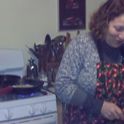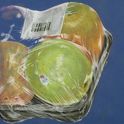How do you cook a cheesecake to achieve a light, crumbly texture, vs. a dense heavy texture? Also, what's a good non-graham cracker crust?
(I'm not a big fan of dense cheesecakes)
8 Comments
jenniebgoodMarch 6, 2012
Just wanted to check back and say I took some of your suggestions - I used whipped cream cheese (per CRC's sugg.), beat the egg whites separately (per Amysarah's sugg.), and whipped "the bejeezus" out of the batter (thanks ChefJune! - love that). I also used a combo of whipped cr. cheese, sour cream, and mascarpone (to lighten the flavor a bit) and added about 1 1/2 tbs. of cornstarch, and the cheesecake came out perfectly! In fact it rose so much in the springform pan that I didn't have any room to put the glaze on it that I had made! I had to serve the glaze on the side. But it came out exactly as I wanted it to. Thanks very much everyone!
berryandcakeFebruary 24, 2012
Thank you all so much for your suggestions!
ChefJuneFebruary 24, 2012
oops! I pressed "Add" before I was really finished. I meant to also add that if what you're after is a fluffier texture, you can make the traditional New York style filling, and when it's all blended, switch to the whisk on your KA mixer and whip the bejeezus out of the batter. The results are no less than spectacular!
ChefJuneFebruary 24, 2012
If you prefer a drier, crumblier cheesecake, try a recipe for Italian Ricotta Pie. The ricotta will yield that texture.
I don't personally care for a crumb crust for my cheesecake. I make a sugar cookie crust. I also do a cheesecake with a banana bread crust. (Both baked completely first before filling.)
I don't personally care for a crumb crust for my cheesecake. I make a sugar cookie crust. I also do a cheesecake with a banana bread crust. (Both baked completely first before filling.)
Helen's A.February 24, 2012
I agree with amysarah - ginger snaps are wonderful!
crcFebruary 24, 2012
Hi, Berryandcake--
I sent you a recipe for light cheesecake a little while ago and just realized there is a typo in the instructions. Where it says "add egg yolks, one at a time", it should say add whole eggs, one at a time. Sorry for the error.
I sent you a recipe for light cheesecake a little while ago and just realized there is a typo in the instructions. Where it says "add egg yolks, one at a time", it should say add whole eggs, one at a time. Sorry for the error.
amysarahFebruary 24, 2012
Try beating the egg whites separately, then folding into the mixture (cream cheese, sugar, egg yolks, etc.) last. And bake in a water bath.
Instead of graham cracker crust, you could do a shortbread crust, or use ginger snaps or sugar cookies or chocolate cookies or amaretti, also possibly add ground almonds, hazlenuts, pecans, etc.
Instead of graham cracker crust, you could do a shortbread crust, or use ginger snaps or sugar cookies or chocolate cookies or amaretti, also possibly add ground almonds, hazlenuts, pecans, etc.
crcFebruary 24, 2012
Use WHIPPED cream cheese (sold in tubs, such as Temptee brand), butter, sour cream, and cornstarch in the cheesecake batter to achieve a lighter texture. The following is a recipe I use:
LIGHT CHEESECAKE
4 8 oz. tubs WHIPPED cream cheese, such as Temptee, at room temperature
16 oz. sour cream, at room temperature
1 stick (1/4 lb) unsalted butter , at room temperature
5 large eggs, at room temperature
2 Tbslp. cornstarch
1 1/4 cups sugar
1/4 tsp. salt
1 1/2 tsp. vanilla
1 tsp. freshly squeezed lemon juice
Preheat the oven to 375°F. Grease a 9-inch by 2 1/2-inch non-stick spring-form pan and line bottom with greased parchment paper. Wrap the outside of the pan with a double layer of heavy-duty aluminum foil to prevent seepage from the water bath in which it will be baked.
In a stand mixer fitted with paddle attachment and set on medium speed, beat the cream cheese, sour cream, and butter to blend. In a separate bowl, whisk together cornstarch, sugar, and salt. Gradually add sugar mixture to cream cheese mixture, beating until well blended. In a small bowl, combine vanilla and lemon juice. Add to cream cheese mixture and blend well.
Add the egg yolks one at a time, beating after each and scraping down the sides of the bowl. Continue to beat until mixture is well blended and smooth.
Pour the batter into the prepared pan. Set the pan inside a larger roasting pan (but one that is no higher than the spring-form pan) and surround it with 1 inch of very hot water. Bake for 1 hour. Turn off the oven and, without opening the door, leave the cake in the oven for 90 minutes.
Remove cake from oven and from water bath and let sit at on a cake rack for 1 to 2 hours until cake reaches room temperature. Cover cake (still in pan) with aluminum foil or plastic wrap and refrigerate until cold throughout, at least 6 hours (overnight is better).
To Unmold: Place pan on heated burner and move it around for 15 seconds. Carefully remove sides of spring-form pan. Use a small, flexible spatula to get under the rim of the pan bottom and under parchment paper to loosen all around, then either lift cake with very large, wide spatula or slide, if possible, to a serving plate. Alternatively, serve cake directly from bottom of spring-form pan placed on a serving plate (no need to heat pan over burner). When cutting cake, take care not to cut through parchment paper—leave it intact on the pan bottom.
LIGHT CHEESECAKE
4 8 oz. tubs WHIPPED cream cheese, such as Temptee, at room temperature
16 oz. sour cream, at room temperature
1 stick (1/4 lb) unsalted butter , at room temperature
5 large eggs, at room temperature
2 Tbslp. cornstarch
1 1/4 cups sugar
1/4 tsp. salt
1 1/2 tsp. vanilla
1 tsp. freshly squeezed lemon juice
Preheat the oven to 375°F. Grease a 9-inch by 2 1/2-inch non-stick spring-form pan and line bottom with greased parchment paper. Wrap the outside of the pan with a double layer of heavy-duty aluminum foil to prevent seepage from the water bath in which it will be baked.
In a stand mixer fitted with paddle attachment and set on medium speed, beat the cream cheese, sour cream, and butter to blend. In a separate bowl, whisk together cornstarch, sugar, and salt. Gradually add sugar mixture to cream cheese mixture, beating until well blended. In a small bowl, combine vanilla and lemon juice. Add to cream cheese mixture and blend well.
Add the egg yolks one at a time, beating after each and scraping down the sides of the bowl. Continue to beat until mixture is well blended and smooth.
Pour the batter into the prepared pan. Set the pan inside a larger roasting pan (but one that is no higher than the spring-form pan) and surround it with 1 inch of very hot water. Bake for 1 hour. Turn off the oven and, without opening the door, leave the cake in the oven for 90 minutes.
Remove cake from oven and from water bath and let sit at on a cake rack for 1 to 2 hours until cake reaches room temperature. Cover cake (still in pan) with aluminum foil or plastic wrap and refrigerate until cold throughout, at least 6 hours (overnight is better).
To Unmold: Place pan on heated burner and move it around for 15 seconds. Carefully remove sides of spring-form pan. Use a small, flexible spatula to get under the rim of the pan bottom and under parchment paper to loosen all around, then either lift cake with very large, wide spatula or slide, if possible, to a serving plate. Alternatively, serve cake directly from bottom of spring-form pan placed on a serving plate (no need to heat pan over burner). When cutting cake, take care not to cut through parchment paper—leave it intact on the pan bottom.
Showing 8 out of 8 Comments
Recommended by Food52
Popular on Food52
Continue After Advertisement


